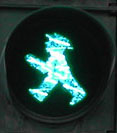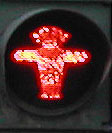 Berlin (9/25 ~ 9/30/2014)
Berlin (9/25 ~ 9/30/2014)

Brandenburg Gate (1791) - the symbol of Prussian Berlin.
It is the last surviving gate in Berlin's old city wall.
The statue is a 4-horse chariot with the Goddess of Peace at the reins.
Napoleon took this statue to Paris in 1806.
After the Prussians defeated Napoleon and got it back (1813), she was
renamed the Goddess of Victory.
Memorial to the Murdered Jews of Europe,
consisting of 2711 gravestone-like pillars of exactly the same size.
Beyond this arch way is the area that used to be Hitler's underground
bunker.
It is now a parking lot. No man-made structure is allowed to be
erected on that site.
( http://www.den-uijl.nl/bunker.html has a map identifying the location of Hitler's underground bunker.)
Remnants of the Berlin wall.
The government had to build a fence to protect these walls from
souvenir-seekers.
Check-Point Charlie - at where an American GI's picture is.
The area became a magnet for tourists, cheap eats, souvenir hawkers and
seedy characters.
Guard your valuables when you are in this area.
Gendarmenmarkt - a pretty square just 4-min walk from our hotel.
This 18th century square has a concert hall (Konzerthaus) flanked by a
French church and a German church.
Many eating options around this square, but it was very quiet in the
evenings in late September.
We read that, the whole square is transformed into a huge Christmas Market during the Holiday Season.
There are 5 world-class museums located on the Museum Island.
We pre-purchased timed-tickets to enter Pergamon Museum on 9/26 at 10am (and had a 30-min window).
So we were looking for signpost to Pergamon Museum's entrance.
The Pergamon Altar is the #1 attraction in Pergamon Museum.
This is a 2nd-century B.C. Greek temple from an ancient Greek city in modern day Turkey.
During the late 19th century the German Empire cultivated good diplomatic relations with the Ottoman Empire.
From 1878-1886 the Berlin Museums excavated the acropolis of Pergamon and
brought back pieces to reassemble.
The frieze wrapping around the temple depicting the Greek gods under Zeus
and Athena defeating the giants.
The 6th century B.C. Ishtar Gate in Babylon dedicated to the goddess Ishtar.
Babylon is in today's Iraq.
The German excavated Babylon from 1899-1917.
In the museum only the first smaller gate on the northern city wall, 15 meters high,
was reconstructed.
The blue glazed tiles with alternative rows of bulls and mythological hybrid dragon.
The dragon, a composite animal, has the head and body of a snake, the front legs of a lion,
the hind legs of a bird and a scorpion's sting in the tail.
The Market Gate of Miletus - from 2nd century A.D.
Miletus was an ancient Greek city then a Roman city in today's Turkey.
The Aleppo Room in Pergamon Museum - the interior of a rich merchant's house in Aleppo.
Aleppo is a very large city in today's Syria, and was
once the Ottoman Empire's third largest city, after Constantinople and Cairo.
After Pergamon museum we went to Berlin Cathedral (Berliner Dom),
also located on the Museum Island.
"Cathedral" is a bad English translation for the word "Dom", which was from
the French word dôme
and means cupola.
On bus 100, the yellow building on the far left is the Berlin Philharmonic Hall.
The Reischtag (國會大廈)
- the Parliament building rebuilt after World War II with a new glass dome
at the top emphasizing the transparency and openness of the new Germany.
The Berlin Zoo entrance.
Curry 36, a popular currywurst stand near Berlin Zoo bus/U-Bahn station.
Workers inside Curry 36 stand, grilling many kinds of currywurst.
You many choose currywurst with skin (like hotdog's skin), ...
... or breaded, thus without a skin.
Some stands sell it with a roll, some without roll but then you can order a
French fry to go with it.
Dunkin Donuts in Berlin had a lot more variety than at home.
The "Mall of Berlin" near Potsdamer Platz with a huge food court on the
third floor.
Our 1st lunch at the food court of the "Mall of Berlin".
A crispy duck breast with noodle and a chicken & fried bean curd with rice
from a Thai vendor.
Notice that they used real plates, not paper plate.
KaDeWe (since 1907) - the largest department store in continental Europe.
The 6th floor of KaDeWe is a gourmet food court.
Most of the ready-to-eat items on this floor listed two prices -
the lower price if you take away, the higher price if you eat here.
The 7th floor of KaDeWe is a glass-domed restaurant called LeBuffet.
In LeBuffet you may assemble your own salad then pay by weight.
The price was 2.99Euro per 100 gram (0.22 pound).
Or you may choose a combination plate at a fixed price posted on the
overhead board.
Mei-Ching had a plate of pork knuckle with potato and cabbage, 14.95Euro.
Vincent had a plate of fresh pasta with mushroom cooked to order, 12.95Euro.
On Sunday morning, Brandenburg Gate was the finish line of Berlin
Marathon.
We took a train to Potsdam. This is Sanssouci Palace in Potsdam.
It was Frederick the Great's favorite summer palace.
A snapshot of the huge gardens surrounding Sanssouci.
Frederick the Great's grave stone in Sanssouci.
Do not understand the German custom of leaving potatoes on a grave stone.
Why not flowers?
Cecilienhof Palace, the former residence of Crown Prince William where
the Potsdam Conference took place for 16 days in July-August of 1945.
The conference room where deals were bartered and boundaries were redrawn.
The other side of the conference room.
One of the many gardens in Cecilienhof.